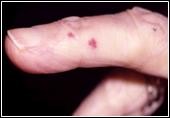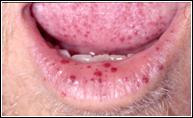Hereditary Hemorrhagic Telangiectasia (HHT)
What is HHT?
Hereditary Hemorrhagic Telangiectasia (HHT) is a hereditary disorder which affects the development of blood vessels. It affects both males and females from all racial and ethnic groups and occurs in approximately 1 in 5000 individuals. A link has recently been discovered between HHT and Juvenile Polyposis. A small number of families have both of these disorders, inherited together, with a change (mutation) in the SMAD4 gene. The SMAD4 gene is a typical JP gene. Though we don’t know the exact numbers yet, it seems that a small percentage of the JP families with SMAD4 mutation also have HHT. So far, it seems that approximately 3% of the HHT families have JP.

HHT is characterized by the presence of abnormal blood vessels. The small abnormal blood vessels are called telangiectases (see photos). These vessels lack a capillary bed, and therefore each telangiectasia is a direct connection between an artery and a vein. They appear as small red spots, on the skin or the lining of the mouth and nose that may be as small as a pin point or as large as a pea in size. When the abnormal blood vessels are larger, they are called arteriovenous malformations (AVMs).

AVMs can develop in the body organs, especially the lungs and brain. Telangiectasia and AVMs are fragile and so have a tendency to bleed (hemorrhage). They can also cause other serious complications, such as stroke and heart failure. The good news is that most of these complications can be prevented with screening and treatment of AVMs, in HHT patients.
How Does HHT Affect A Person?
The location of telangiectasia or AVMs will determine how HHT will affect an individual. Approximately 90% of adults with HHT will have recurrent nosebleeds and have telangiectases on the skin of the hands, face or in the mouth. Many patients with HHT will have iron-deficiency anemia, from chronic blood loss from the nose. Approximately 20% of adults with HHT will also have some chronic bleeding from telangiectases in the stomach and small bowel. Approximately 30% of people with HHT will have AVMs in the lungs and 10% will have AVMs in the brain. The lung and brain AVMs put patients at risk of stroke as well as bleeding. Most HHT patients will have telangiectases in the liver but only rarely do these cause symptoms. Children can have HHT too, as it is an inherited disorder, but the symptoms and complications are less frequent in children.
Can HHT Be Treated?
Yes. Although there is not yet a way to prevent telangiectases or AVMs from developing, most can be treated to prevent complications. Most organ AVMs are treated with high-tech minimally invasive treatment through the blood vessels, though the exact type of treatment depends on the size and location of the AVMs. When to consider HHT?
It is important to consider HHT if someone has recurrent nosebleeds, as well as a family history of nosebleeds, especially if they have telangiectasias. A history of organ AVMs in several family members is also very suggestive. Genetic testing and HHT
Genetic testing for HHT is available. It is primarily used for the relatives of an HHT patient, to determine which of them have inherited the HHT. Currently two genes have been identified as causing HHT, Endoglin and ALK-1. These do not appear to be associated with JP. SMAD4 testing is also available, for HHT families, JP families and families with the suspected combined syndrome. Please contact the Registry at 416-586-4800 ext 5112 for additional information.
Resources
Detailed information about HHT can be found at the HHT Foundation International website https://curehht.org/.
There are four Canadian Specialized HHT Centres, in Toronto (https://www.hhttoronto.com/), Montreal, Edmonton and Vancouver.
